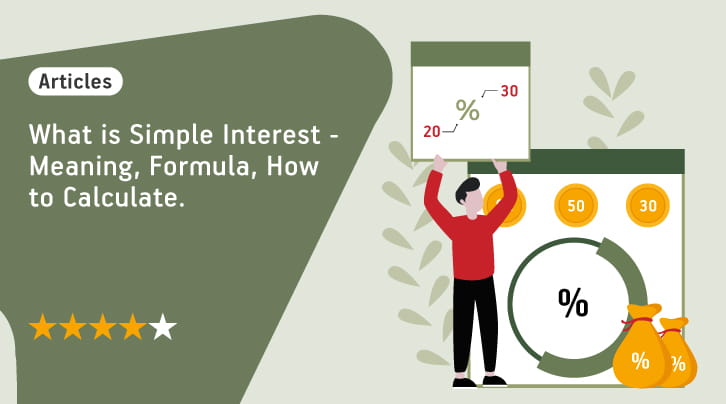-
Our Products
Our FundsFocus Funds
-
Self Care
Self-ServiceFind InformationWays To TransactPartner Solutions
-
Downloads
- Learnings
- About Us
-
More
-
Shareholders
-
Shareholders
-
Updates
-
-
SIP Calculators
- Back
-
Shareholders
What is Simple Interest?

Jan 29, 2024
5 min
4 Rating
When obtaining a loan, one must carefully consider the associated costs. Whether you're seeking financing for a home purchase or a renovation project, minimising your interest rate is a priority. On the flip side, from an investor's perspective, higher interest rates provide an opportunity for greater returns. Interest can manifest in either a simple or compound form. Confused about the distinctions between simple and compound interest? We'll provide clear definitions for both concepts and illustrate them with numerous examples.
Simple interest is a straightforward method used to determine the interest charged on a principal sum over a specified rate and time period. Unlike compound interest, where interest is added to the Principal for each subsequent period, simple interest maintains a constant principal amount.
In this blog, we will delve into the simple interest meaning, particularly as it pertains to borrowing. Key terms such as Principal, amount, rate of interest, and time period will be introduced, enabling you to calculate simple interest using the applicable formula.
What is Simple Interest?
Simple interest serves as a method for determining the proportion of interest accrued on a sum over a specified time period at a fixed rate. Notably, the principal amount remains constant throughout the calculation process. This technique is both straightforward and uncomplicated, making it an accessible means of calculating interest on a monetary sum.
As per the simple interest meaning, the application of interest consistently pertains to the initial principal amount, with the rate of interest remaining consistent for each cycle of time.
Once you grasp the concept of simple interest, understanding its formula becomes essential. The formula for calculating simple interest is expressed as follows:
S.I. = (P × R × T)/100,
● P represents the Principal amount.
● R stands for the Rate of Interest per annum, expressed as a percentage.
● T denotes time, typically measured in years. The rate of interest is represented as a percentage, denoted by R%.
How To Calculate Simple Interest?
Understanding the calculation of simple interest involves specific input parameters, namely the principal amount, the rate of interest, and the time. The principal amount represents the money lent by an investor to a borrower, denoted as (P) in the formula. The rate refers to the percentage charged by the investor, and it is based on the Principal. In many instances, the annual interest rate can be correlated with various time periods. To compute simple interest, follow these steps:
Select The Formula And Enter Your Numbers
Utilise the following formula for simple interest calculation:
I=P × R × t
In this equation, 'I' represents the simple interest, 'P' denotes the principal amount, 'R' stands for the rate, and 't' signifies the time, which indicates the duration of a loan or investment.Correspond measures of time
It is crucial to align the regular interest rate with the duration of the loan. For instance, if the interest rate is compounded monthly and the loan spans two years, it's vital to express the time period as 24 months. Failing to do so may lead to inaccurate results.
Find the decimal form
The interest rate is often expressed in percentage form, and the corresponding decimal form can be derived by dividing the percentage by 100. This conversion can be accomplished using the following formula:
I = P * (R/100) * t
Simple Interest vs Compound Interest
Two categories of interest exist: simple interest and compound interest. In this specific article, our emphasis has been on simple interest (S.I.). Now, let's delve into understanding the distinction between simple interest and compound interest.
Compound Interest |
|
Every time, the S.I. is calculated on the initial principal amount. |
When compared to S.I., compound interest is calculated on the sum of Principal and interest collected. |
In this type of interest, the principal amount is fixed. |
Throughout the duration of the loan time, the principal amount fluctuates regularly. |
S.I. is determined using the following formula: S.I.=(P×R×T)/100 |
The formula for calculating CI is as follows: |
The S.I. is the same for every year on a given principle. |
Compound interest changes over time because it is calculated on the amount rather than the Principal. |
A sum invested using S.I. yields a lower return. |
The same amount invested utilising CI yields much better returns. |
Which Will Give More Returns Over Time, Simple or Compound Interest?
In contrast to compound interest, simple interest is simpler to calculate and comprehend. When dealing with a short-term loan or one with non-compounding interest, the concern revolves around the interest added to the outstanding principal balance. Notably, with certain loans like mortgages and many car loans, simple interest accrues but does not compound.
In the context of investments, compound interest holds an advantage as it facilitates faster fund growth compared to an account featuring a simple interest rate. Compound interest plays a significant role in calculating the annual percentage yield, representing the annual rate of return or the annual cost of borrowing money.
The decision between simple and compound interest hinges on whether you are saving or borrowing. Compound interest proves advantageous when saving money in an account or receiving repayment for a loan. On the contrary, simple interest results in lower payments over time if you borrow money. Additionally, suppose you wish to ascertain the cumulative interest paid on a loan over a specific period. In that case, a straightforward sum of those payments will provide the total interest amount.
Conclusion
Simple interest is the calculated interest charge on a loan, using solely the initial principal amount and a fixed interest rate that remains constant. Unlike compounding, where interest accumulates on both the Principal and accrued interest over multiple payment periods, simple interest does not involve this compounding mechanism.
For borrowers, simple interest can be advantageous due to its comparatively lower cost of borrowing. However, it's important to note that its straightforward calculation provides only a basic estimate of costs and may not encompass other charges or fees associated with the loan.
Mutual Fund investments are subject to market risks, read all scheme related documents carefully.
FAQ's





 1800-270-7000
1800-270-7000



